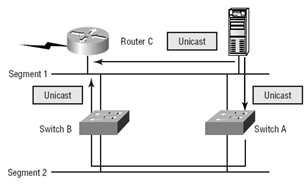Do you know what a network loop is? Have you ever had a network loop in your LAN? So what happens when there is a loop on your Cisco network?
First, let?s look at what a network loop means? A network loop is a network configuration where there is more than one path between two computers or devices, which causes packets to be constantly repeated. This is due to the fact that a hub will blindly transmit everything it receives to all connections ? other devices, such as switches and routers, might be able to reduce or eliminate this problem.
Technically, a Network loop occurs in computer networks when there is more than one Layer 2 (OSI model) path between two endpoints (e.g. multiple connections between two network switches or two ports on the same switch connected to each other).

FIGURE 1
The loop creates broadcast storms as broadcasts and multicasts are forwarded by switches out every port, the switch or switches will repeatedly rebroadcast the broadcast messages flooding the network. Since the Layer 2 header does not support a time to live (TTL) value, if a frame is sent into a looped topology, it can loop forever.
The server in the figure sends a unicast frame to Router C. Since it?s a unicast frame, Switch A forwards the frame, and Switch B provides the same service ? it forwards the unicast. This is bad because it means that Router C receives that unicast frame twice, causing additional overhead on the network.one: The MAC address filter table will be totally confused about the device?s location because the switch can receive the frame from more than one link.

FIGURE 2
LOOP AVOIDANCE
Redundant links between switches is a good idea because they help prevent complete network failures in the event one link stops working. However, they often cause more problems because frames can be flooded down all redundant links simultaneously, this creates network loops.
A looped topology is often desired to provide redundancy, but looped traffic is undesirable. The Spanning-Tree protocol was originally designed for bridges. Today, it is also applied to LAN switches and routers operating as a bridge. Spanning-Tree protocol ensures that all bridged segments are reachable but any points where loops occur will be blocked.

FIGURE 3
Redundancy in a network is extremely important because redundancy allows networks to be fault tolerant. Redundant topologies based on switches and bridges are subject to broadcast storms, multiple frame transmissions, and MAC address database instability. Therefore, network redundancy requires careful planning and monitoring to function properly. The Spanning-Tree Protocol is used in switched networks to create a loop free network.
Some of the terms used in Spanning-Tree Protocol
BPDU Bridge Protocol Data Unit (BPDU) ? All the switches exchange information to use in the selection of the root switch
Bridge ID ? The bridge ID is how STP keeps track of all the switches in the network. It is determined by a combination of the bridge priority (32,768 by default on all Cisco switches) and the base MAC address.
Root Bridge -The bridge with the lowest bridge ID becomes the root bridge in the network.
Nonroot bridge ? These are all bridges that are not the root bridge.
Root port ? The root port is always the link directly connected to the root bridge or the shortest path to the root bridge. If more than one link connects to the root bridge, then a port cost is determined by checking the bandwidth of each link.
Designated port ? A designated port is one that has been determined as having the best (lowest) cost. A designated port will be marked as a forwarding port
Nondesignated Port ? A nondesignated port is one with a higher cost than the designated port. Nondesignated ports are put in blocking mode
Forwarding Port ? A forwarding port forwards frames
Blocked Port ? A blocked port is the port that will not forward frames, in order to prevent loops
Writer: Abdulrazaq Ameen (MCP, MCSA, CCNA). Technical Support Staff at Techspecialist Consulting Limited

